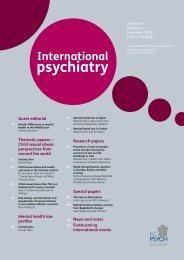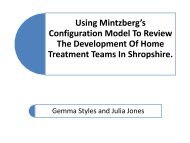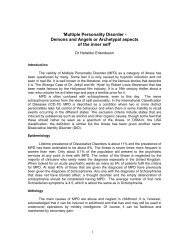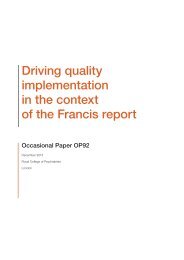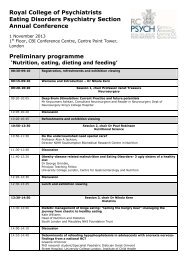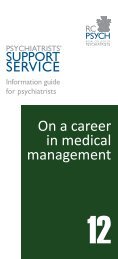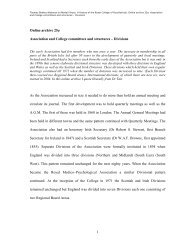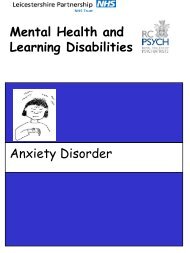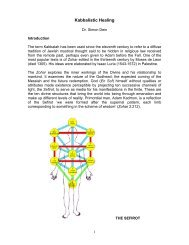An emperor in parapsychology
An emperor in parapsychology
An emperor in parapsychology
You also want an ePaper? Increase the reach of your titles
YUMPU automatically turns print PDFs into web optimized ePapers that Google loves.
<strong>An</strong> <strong>emperor</strong> <strong>in</strong> <strong>parapsychology</strong><br />
Dr James Paul Pandarakalam<br />
Professor Ian Stevenson, who was a pioneer <strong>in</strong> research <strong>in</strong>to ‘past<br />
lives’ passed away peacefully on 8 th February 2007. He died from<br />
bronchopneumonia, hav<strong>in</strong>g suffered from bronchial defects s<strong>in</strong>ce childhood.<br />
Dr. Stevenson believed that a person’s cause of death might be traced to his<br />
previous life, and speculated that his own bronchial defects might have a past<br />
life aetiology.<br />
Dr Stevenson published a detailed essay on children remember<strong>in</strong>g<br />
previous lives <strong>in</strong> 1960, which caught the attention of Chester Carlson. Carlson<br />
was the <strong>in</strong>ventor of the Photostat mach<strong>in</strong>e. He f<strong>in</strong>anced Stevenson’s<br />
researches s<strong>in</strong>ce he believed that he got the <strong>in</strong>spiration for his <strong>in</strong>vention<br />
paranormally. Stevenson travelled an average of 55,000 miles every year,<br />
becom<strong>in</strong>g the author of 200 papers and n<strong>in</strong>e books. His <strong>in</strong>terests spread to<br />
apparitions, poltergeists, and mediumship, near-death experiences and<br />
deathbed observations. Earlier publications <strong>in</strong>cluded two books on psychiatric<br />
<strong>in</strong>terview<strong>in</strong>g and diagnosis. Even his staunchest critics have respect for his<br />
scientific methodology and scientific honesty. Stevenson had a tower<strong>in</strong>g<br />
personality. His book, ‘Re<strong>in</strong>carnation and Biology’ is a classic study of<br />
<strong>parapsychology</strong>, herald<strong>in</strong>g a paradigmatic shift from physics to biology. 1<br />
The phenomenon of children remember<strong>in</strong>g previous lives has existed<br />
throughout the centuries, particularly <strong>in</strong> the Orient. The Mughal Emperor<br />
Akbar was the first to have been documented to study such a case. Dr Ian<br />
Stevenson’s <strong>in</strong>vestigatory studies have become a benchmark <strong>in</strong> this<br />
challeng<strong>in</strong>g research field.<br />
Even though there are different types of evidence to support belief <strong>in</strong><br />
re<strong>in</strong>carnation, children’s memories about previous lives have more scientific<br />
credibility. Most of these cases have the follow<strong>in</strong>g pattern. 2<br />
A child, usually at the age of two or three, beg<strong>in</strong>s talk<strong>in</strong>g persistently of<br />
th<strong>in</strong>gs, places and people about which the parents are thoroughly<br />
ignorant. The child may even behave quite differently from his brothers<br />
or sisters. This will appear very strange <strong>in</strong> terms of the circumstances<br />
of his upbr<strong>in</strong>g<strong>in</strong>g. F<strong>in</strong>ally, the child himself may relate all this to a<br />
previous life he claims to remember hav<strong>in</strong>g led, sometimes <strong>in</strong><br />
neighbour<strong>in</strong>g places or <strong>in</strong> a distant place.<br />
This is very try<strong>in</strong>g for the parents who, along with friends of the family,<br />
start to enquire about persons presumed to be dead to whom the child’s<br />
statements might apply. F<strong>in</strong>ally, they f<strong>in</strong>d a family that appears to fit the basis<br />
of the statements. Once contact is made with this new family, they get<br />
additional <strong>in</strong>formation. Some of this <strong>in</strong>formation verifies and some contradicts<br />
the child’s statements. At the end of the <strong>in</strong>quiry, the child may be taken to the<br />
family he claims was his orig<strong>in</strong>al family. This family may belong to a superior<br />
or <strong>in</strong>ferior social stratum.<br />
As time goes on, both the families make arrangements for a reunion.<br />
1
The child takes his parents and others through complicated streets and alleys.<br />
He may show somnambulistic precision. He leads the group directly to the<br />
place where he claims to have lived or worked <strong>in</strong> his former life. He then<br />
greets various persons who have come to witness this reunion. He calls them<br />
by their name and behaves appropriately. The child likes and dislikes special<br />
idiomatic phrases; nicknames and names for objects <strong>in</strong> his alleged previous<br />
life are recollected.<br />
All these cases have some common <strong>in</strong>gredients. There are repeated<br />
statements of a young child’s identification with a deceased person. These<br />
children who remember past lives offer <strong>in</strong>formation about this person <strong>in</strong> the<br />
form of memories of people known to him. They ask to return to their previous<br />
homes and present familiar behaviour <strong>in</strong> the apparently strange environment.<br />
They address the alleged relatives with appropriate emotional responses.<br />
Most of these memories vanish between the ages of seven and n<strong>in</strong>e. All these<br />
could suggest some cont<strong>in</strong>uity of personality hidden <strong>in</strong> the sublim<strong>in</strong>al self.<br />
Different Interpretations<br />
There is always the chance of fraud <strong>in</strong> such cases. The parents of<br />
some of these children have been alleged to make money out of them. They<br />
tra<strong>in</strong> them to enact the drama of re<strong>in</strong>carnation. But <strong>in</strong> the most historical<br />
cases, there is sufficient evidence to rule out fraud. There is also the<br />
possibility of unconscious fraud. The child may be referr<strong>in</strong>g to someone he<br />
read or heard about, identify<strong>in</strong>g himself with this person. The parents may<br />
have unconsciously added more to the tale as they retold it. Jurgen Keil refers<br />
to these types of cases as un<strong>in</strong>tentional <strong>in</strong>formation transfer (as compared to<br />
normal <strong>in</strong>formation transfer). 3 The present author has exam<strong>in</strong>ed such a case<br />
of un<strong>in</strong>tentional <strong>in</strong>formation transfer <strong>in</strong> Kerala (South India).<br />
Psychologists now refer to the concept of ‘racial memory’. But this idea<br />
cannot account for the apparent memories of former lives. These children are<br />
almost never descendants of the <strong>in</strong>dividuals they claim to be, usually<br />
belong<strong>in</strong>g to another family <strong>in</strong> another town.<br />
<strong>An</strong>other possibility is that the child may have received <strong>in</strong>formation<br />
about the deceased person’s life through extrasensory perception. Relatives<br />
still mourn<strong>in</strong>g the deceased might unconsciously be send<strong>in</strong>g thoughts, which<br />
are picked telepathically by the youngsters. The observation that these<br />
children do not show any unusual paranormal ability <strong>in</strong> other situations is a<br />
counter-argument aga<strong>in</strong>st the telepathic hypothesis.<br />
Professor Chari advocates a spiritist <strong>in</strong>terpretation to expla<strong>in</strong> previous<br />
life memories. This postulates that discarnate spirits from the non-physical<br />
realm are <strong>in</strong>fluenc<strong>in</strong>g these children by transmitt<strong>in</strong>g their terrestrial memories<br />
to the children. 4 If that was the case, the children would have been <strong>in</strong>fluenced<br />
by several deceased personalities and the subjects would not have been able<br />
to stick to one previous life narration alone. It can also be argued that if<br />
previous life memories were spiritist <strong>in</strong> orig<strong>in</strong>, more than one child would be<br />
claim<strong>in</strong>g the identity of a s<strong>in</strong>gle discarnate personality and this has not<br />
happened.<br />
Children have not claimed the lives of more than one deceased<br />
personality liv<strong>in</strong>g <strong>in</strong> the same period of time. Nor have they claimed the<br />
memories of liv<strong>in</strong>g ones. It is also of note that dur<strong>in</strong>g the Near Death<br />
2
Experience (NDE) stage, no panoramic review of a former life is described <strong>in</strong><br />
the NDEs of cultures believ<strong>in</strong>g <strong>in</strong> re<strong>in</strong>carnation.<br />
The apparent memories for most of the subjects occur dur<strong>in</strong>g a normal<br />
state of consciousness. Some mediums who have had experiences with<br />
communications from ostensibly discarnate personalities (and also apparent<br />
memories of former <strong>in</strong>carnations) claim to dist<strong>in</strong>guish between these k<strong>in</strong>ds of<br />
experiences. In mediumistic experiences, the communicators do not conf<strong>in</strong>e<br />
their <strong>in</strong>formation to one person.<br />
With these arguments, Dr. Stevenson rules out the possibility of<br />
communication from surviv<strong>in</strong>g personality. 6 He also argues aga<strong>in</strong>st the<br />
hypothesis of possession because no transformation of personality occurs <strong>in</strong><br />
these cases.<br />
The average <strong>in</strong>terval between death and rebirth <strong>in</strong> the published cases<br />
of Stevenson is two years, even though there are reports of trans-century<br />
cases of re<strong>in</strong>carnation. Most of the re<strong>in</strong>carnations take place <strong>in</strong> the same<br />
geographical area but there are also <strong>in</strong>ternational cases. The social<br />
circumstances are variable and do not follow a set pattern.<br />
‘Deja vu,’ hypnotic past life regression, flashbacks occurr<strong>in</strong>g <strong>in</strong> drug<br />
<strong>in</strong>duced mental states and recurrent dreams start<strong>in</strong>g from childhood, offer<br />
other probable but weaker evidences for re<strong>in</strong>carnation. Dr Stevenson is<br />
sceptical about the research usefulness of hypnotic past life regression (PLR)<br />
7 , but gives some credit to PLR when there is responsive xenoglossy, <strong>in</strong> which<br />
the subject is capable of to and fro communication <strong>in</strong> a foreign language . 8<br />
Birth Marks and Birth Defects<br />
In his recent publication, Dr. Stevenson has opened his bulky file of<br />
cases where re<strong>in</strong>carnated persons have birth marks and birth defects<br />
correspond<strong>in</strong>g to the wounds of the deceased person. 9 About 35% of children<br />
who claim to remember previous lives have birth-marks and birth defects that<br />
they attribute to wounds on a person whose life the child remembers. Dr.<br />
Stevenson’s research team has <strong>in</strong>vestigated the cases of 210 such children.<br />
Photographs of birthmarks and illustrations of the weapons form part of the<br />
evidence <strong>in</strong> this explorative research. The birth marks were usually areas of<br />
hairless, puckered sk<strong>in</strong>, some were areas of <strong>in</strong>creased pigmentation and<br />
some were areas of little or no pigmentation. The birth defects were nearly<br />
always of rare types.<br />
In cases <strong>in</strong> which a deceased person was identified, the details of<br />
whose life unmistakably matched the child’s statements, a close<br />
correspondence was nearly always found between the birthmarks and birth<br />
defects on the child and wounds on the deceased person. In 43 of 49 cases <strong>in</strong><br />
which a medical document was obta<strong>in</strong>ed, it confirmed the correspondence<br />
between wounds and birthmarks or birth defects. Dr. Stevenson argues <strong>in</strong><br />
favor of a paranormal orig<strong>in</strong> for these birth manifestations, exclud<strong>in</strong>g reasons<br />
for maternal impressions as causative factors. Currently, the objective<br />
evidence <strong>in</strong> favor of the hypothesis of re<strong>in</strong>carnation is the presence of<br />
birthmarks and birth defects correspond<strong>in</strong>g to the wounds of the deceased<br />
persons. Pasricha <strong>in</strong> her report of ten such cases, after discuss<strong>in</strong>g the<br />
alternative explanations of chance, maternal impressions, super-psi and<br />
possession, proposes that the hypothesis of re<strong>in</strong>carnation may best expla<strong>in</strong><br />
3
these cases. 10<br />
The simplest normal explanation for this phenomenon might appear to<br />
be chance. But the multiplicity of the birthmarks correspond<strong>in</strong>g to the wounds<br />
of the deceased person whose life the subject remembers, and the unusual<br />
nature of the birthmarks cannot be expla<strong>in</strong>ed away as a mere co<strong>in</strong>cidence.<br />
The sk<strong>in</strong> of a normal sized adult would comprise 160 squares each ten<br />
centimeters sq. Locat<strong>in</strong>g the sk<strong>in</strong> marks with<strong>in</strong> such a grid, the odds aga<strong>in</strong>st<br />
chance of a s<strong>in</strong>gle birthmark correspond<strong>in</strong>g <strong>in</strong> location with a s<strong>in</strong>gle wound is<br />
1/160. But the chance explanation becomes much weaker <strong>in</strong> which more than<br />
one wound and birthmark correspond. For example Stevenson has eighteen<br />
cases <strong>in</strong> which a child claims to remember be<strong>in</strong>g shot by a bullet, and has two<br />
birth marks which are found to correspond to bullet wounds of entry (small)<br />
and exit wound (larger). Here aga<strong>in</strong> a pattern of birthmarks matches the<br />
pattern of wound<strong>in</strong>g of the deceased. These cases constitute the strongest<br />
evidence. When two birthmarks thus correspond with two wounds, the odds<br />
aga<strong>in</strong>st chance <strong>in</strong>crease to 1/60 <strong>in</strong>to 1/160 or 1/25000. <strong>An</strong> extreme case is<br />
Necip of Turkey who had seven birth Marks, six of which correspond to<br />
wounds described <strong>in</strong> a medical document. 8 In this case the odds aga<strong>in</strong>st<br />
chance co<strong>in</strong>cidence are truly astronomical.<br />
Of the paranormal explanations, the hypothesis of maternal<br />
impressions <strong>in</strong> the strongest theory. 11 Accord<strong>in</strong>g to this hypothesis, shock or<br />
strong psychological impression <strong>in</strong> pregnant women can produce a mark or<br />
other defects <strong>in</strong> her baby. Aga<strong>in</strong>, this hypothesis is valid only <strong>in</strong> cases where<br />
the two families knew each other. In majority of the cases, they were<br />
strangers. Above all else, the cognitive and behavioral memories po<strong>in</strong>t<br />
towards the hypothesis of re<strong>in</strong>carnation if the <strong>in</strong>formants are reliable.<br />
Re<strong>in</strong>carnation and M<strong>in</strong>d Bra<strong>in</strong> Relationship<br />
Medical scientists can safely leave the discussion of the soul to the<br />
theology and conf<strong>in</strong>e themselves to the m<strong>in</strong>d and its relation to the bra<strong>in</strong>.<br />
Neurophysiology has failed to expla<strong>in</strong> the m<strong>in</strong>d. If re<strong>in</strong>carnation is true, one<br />
has to accept a dualistic model of the m<strong>in</strong>d.<br />
The human m<strong>in</strong>d consists of a complex non-atomic energy system<br />
<strong>in</strong>corporated with<strong>in</strong> an atomic system. This is an assertion. If the m<strong>in</strong>d<br />
consists of a non-physical component, fundamental questions need to be<br />
answered as to how physical sensations are converted <strong>in</strong>to non-physical form.<br />
This is a hypothesis. The two do not sit well together. The mechanism of<br />
synaesthesia, where sensory stimuli from one modality are perceived <strong>in</strong><br />
another modality, may conta<strong>in</strong> the secret to unlock the conversion of energy<br />
from the atomic to the non-atomic and sub-atomic levels.<br />
A theory that accommodates the hypothesis of re<strong>in</strong>carnation is C.D.<br />
Broad’s ‘compound theory’. Accord<strong>in</strong>g to him, the m<strong>in</strong>d is not a s<strong>in</strong>gle<br />
substance. It is a compound of two substances and neither of them by itself<br />
has the characteristic of the m<strong>in</strong>d. These two substances are the ‘psychic<br />
factor’ and the ‘bodily factor’, as he called them <strong>in</strong> 1925. He later called the<br />
former the ‘psi-component’. Follow<strong>in</strong>g the death of the physical body of a<br />
person, the psi-component may cont<strong>in</strong>ue an unembodied existence for a time.<br />
It may then become associated with another physical body before birth. It<br />
follows from this hypothesis that certa<strong>in</strong> aspects of the psi-component may<br />
4
<strong>in</strong>fluence the personality of the new human be<strong>in</strong>g, his mental contents,<br />
behaviour and even physical body. Dr. Stevenson has co<strong>in</strong>ed the term<br />
‘psychophore’ which means soul bearer, the canvas where memories are<br />
collected. 12<br />
The present tendency among medical scientists to use genetics and<br />
environmental <strong>in</strong>fluences to expla<strong>in</strong> human behaviour and various medical<br />
conditions is under attack from <strong>parapsychology</strong>. 13 Psychiatric disorders need<br />
particular mention <strong>in</strong> this respect. In general psychiatric disorders have no<br />
objective <strong>in</strong>dicators and their <strong>in</strong>vestigations conta<strong>in</strong> potential errors when<br />
genetic theories are adhered closely to. The idea of re<strong>in</strong>carnation offers<br />
supplementary knowledge without replac<strong>in</strong>g the knowledge ga<strong>in</strong>ed through<br />
studies of genetics and environmental <strong>in</strong>fluences. 14 Parapsychology is not an<br />
adversary of medical sciences but offers a third or extra explanation to solve<br />
some of the puzzles <strong>in</strong> psychology, and medic<strong>in</strong>e. 15<br />
Stevenson’s research works have been useful <strong>in</strong> deal<strong>in</strong>g with some of<br />
the myths surround<strong>in</strong>g re<strong>in</strong>carnation. He has given more <strong>in</strong>sight <strong>in</strong>to the ageold<br />
Indian concept of retributive karma and modified it as developmental<br />
karma or even as collective karma. The concept of ‘cl<strong>in</strong>ical re<strong>in</strong>carnation’ is<br />
his great contribution to medical sciences. 16 Stevenson did not promote<br />
universal re<strong>in</strong>carnation but was <strong>in</strong>cl<strong>in</strong>ed to believe <strong>in</strong> accidental re<strong>in</strong>carnation.<br />
This goes well with the concept of re<strong>in</strong>carnation <strong>in</strong> the ancient Vedas which<br />
states ‘Those who leave the world <strong>in</strong> darkness return, and those who leave <strong>in</strong><br />
light never return’ (Bhagavat Gita, 8:25-26).<br />
Unfortunately the Vedic concept of re<strong>in</strong>carnation came to be exploited<br />
to cement the caste hierarchy of India and H<strong>in</strong>dus have been forced to believe<br />
that the enlightened get <strong>in</strong>to the higher caste <strong>in</strong> the cycle of rebirth. Such a<br />
view contradicts Jesus’ beatitudes, <strong>in</strong> which the poor are more spiritually<br />
enlightened and promised eternal life. Incidentally, Stevenson did not f<strong>in</strong>d any<br />
evidence for transmigration to and from the animal k<strong>in</strong>gdom.<br />
To see karma fatalistically is a negative philosophy. Dr Venkoba Rao<br />
has attempted to expla<strong>in</strong> karma differently us<strong>in</strong>g the analogy of the archer with<br />
the bows and arrows. 17 The archer has no control on the arrows that have<br />
been already discharged, but can control the arrow set on the bow ready to be<br />
discharged and those still <strong>in</strong> the quiver. Humans have control on most of their<br />
actions and only a few are predeterm<strong>in</strong>ed <strong>in</strong> a previous life.<br />
Stevenson did not want his research to be associated with any religion.<br />
Asked about the usefulness of elicit<strong>in</strong>g previous life memories artificially, he<br />
stated, ‘To paraphrase from Jesus Christ, sufficient unto one life is the evil<br />
thereof’. I had thirty years of postal correspondence with Stevenson and his<br />
papers on apparitions have been highly helpful for my studies of Marian<br />
apparitional experiences, but Stevenson always admitted his ignorance on<br />
Mary’s appearances, and was humble enough not to comment on their<br />
authenticity.<br />
One th<strong>in</strong>g certa<strong>in</strong> about parapsychological <strong>in</strong>terpretations is their<br />
uncerta<strong>in</strong>ty. 18 Psychological superficiality, circular logic and lack of deeper<br />
understand<strong>in</strong>g of the culture that Stevenson <strong>in</strong>vestigated, are some of the<br />
arguments aga<strong>in</strong>st his <strong>in</strong>vestigations. Telepathy from liv<strong>in</strong>g agents and spiritist<br />
<strong>in</strong>terpretations are two salient alternative paranormal <strong>in</strong>terpretations that can<br />
also be considered. Even though Stevenson has discussed <strong>in</strong> detail all the<br />
alternative explanations of re<strong>in</strong>carnation cases, it is to be po<strong>in</strong>ted out that he<br />
5
paid less attention to the spiritist hypothesis. In general, oriental religions have<br />
a mediumistic <strong>in</strong>cl<strong>in</strong>ation, and this would support the spiritist view of<br />
re<strong>in</strong>carnation-type cases and the high prevalence of reported cases <strong>in</strong> the<br />
East.<br />
If that is the case, re<strong>in</strong>carnation may be a faulty <strong>in</strong>terpretation of what<br />
are spiritist phenomena. Possibly children are more vulnerable to spiritist<br />
<strong>in</strong>fluences and that hav<strong>in</strong>g recently passed through the spiritual dimension,<br />
re<strong>in</strong>carnated children are more susceptible to spirit attachment. (The<br />
Ogbngees of the Igbo tribe of Nigeria believe <strong>in</strong> such a coexistence of spirit<br />
attachment and re<strong>in</strong>carnation, and Stevenson has discussed such cases <strong>in</strong><br />
detail. 19,20 ) If Stevenson’s cases do not prove re<strong>in</strong>carnation and spiritistc<br />
<strong>in</strong>terpretation is proven to be true, these re<strong>in</strong>carnation-type cases still would<br />
<strong>in</strong>directly offer a strong evidence for a spiritistic realm and post-mortem<br />
existence, and children remember<strong>in</strong>g previous lives will cont<strong>in</strong>ue to be a<br />
fasc<strong>in</strong>at<strong>in</strong>g paranormal phenomenon.<br />
In summary, Stevenson’s pa<strong>in</strong>stak<strong>in</strong>g research has made the idea of<br />
re<strong>in</strong>carnation a respectable research topic and subject to the scrut<strong>in</strong>y of<br />
scientific empiricism. Stevenson himself has stated, ‘I have no preferred<br />
<strong>in</strong>terpretation for all cases, and I do not th<strong>in</strong>k any s<strong>in</strong>gle one of them offers<br />
compell<strong>in</strong>g evidence of re<strong>in</strong>carnation. Yet I can say that I th<strong>in</strong>k re<strong>in</strong>carnation<br />
is, for some cases, the best <strong>in</strong>terpretation. I am not claim<strong>in</strong>g that it is the only<br />
possible <strong>in</strong>terpretation for these cases, just that it seems to be the best one<br />
among all those that I have <strong>in</strong>terpreted.’ 9<br />
Stevenson wrote to me once ‘ My aim has never been to prove<br />
re<strong>in</strong>carnation, but only to f<strong>in</strong>d and report whatever evidence there is that<br />
makes it seem possible’.<br />
To end on a biographical note, Dr Ian Pretyman Stevenson was born<br />
on 31 st October 1918 <strong>in</strong> Montreal. His mother was <strong>in</strong>terested <strong>in</strong> Theosophy<br />
and had a huge collection of books on the subject, which was a source of<br />
<strong>in</strong>spiration for his <strong>in</strong>terest <strong>in</strong> psychical studies <strong>in</strong> later life. Dr Stevenson<br />
studied medic<strong>in</strong>e at St <strong>An</strong>drews University <strong>in</strong> Scotland, transferr<strong>in</strong>g his studies<br />
to Canada due to the outbreak of the Second World War. He graduated <strong>in</strong><br />
medic<strong>in</strong>e from McGill University and later migrated to USA. After his <strong>in</strong>ternship<br />
he specialised <strong>in</strong> psychiatry, also tra<strong>in</strong><strong>in</strong>g as a psychoanalyst. However, he<br />
lost confidence <strong>in</strong> psychoanalysis and even referred to Sigmund Freud as a<br />
‘proverbial naked <strong>emperor</strong>’.<br />
Only time will tell whether or not Ian Stevenson was himself a clothed<br />
<strong>emperor</strong>. Freed from the dogmatism of Freud, the mystical speculations of<br />
Carl Jung, and the paternalism of Alfred Adler, Dr. Stevenson <strong>in</strong>troduced a<br />
new school of th<strong>in</strong>k<strong>in</strong>g and will be regarded as the first cartographer of the<br />
new science-landscape. Scientists who seek truth and not proof alone to<br />
support their observations are also theologians, and Stevenson was one<br />
among them.<br />
References<br />
1. Bauer H. Henry (2007) Science: Past, Present and Future. Journal of<br />
6
Scientific Exploration, Vol 12, No1 pp141-155<br />
2. Stevenson Ian (1987) The Children Who Remember Previous Lives. The<br />
University Press of Virg<strong>in</strong>ia, Charlottesville.<br />
3. Keil Jurgen (1996) Cases of re<strong>in</strong>carnation type. Journal of Scientific<br />
Exploration Volume 10 No.4.<br />
4. Chari C.T.H. (1967) Paramnesia and Re<strong>in</strong>carnation Proceed<strong>in</strong>gs<br />
S.P.R.December. Vol 53. P, 193.<br />
5. Kunhardt Schrotter Mihael (1993). A review of Near Death<br />
Experiences. Journal of Scientific Exploration. Vol 7. No 3<br />
6. Stevenson Ian (1974). Twenty Cases Suggestive of Re<strong>in</strong>carnation. The<br />
University Press of Virg<strong>in</strong>ia, Charlottesville.<br />
7. Stevenson Ian (1994). A Case of the Psychotherapists' Fallacy, Hypnotic<br />
Regression to Previous Lives. Am J of Cl<strong>in</strong>ical Hypnosis 36:188-193.<br />
8. Stevenson Ian (1984) Unlearned Language, New Studies <strong>in</strong> Xenoglossy.<br />
Charlottesville University Press of Virg<strong>in</strong>ia.<br />
9. Stevenson Ian (1997). Re<strong>in</strong>carnation and Biology. Praeger Publishers.<br />
Westport.<br />
10. Pastricha Satwant (1998). Case of re<strong>in</strong>carnation type <strong>in</strong> Northern India<br />
with Birthmarks and birth Defects. Journal of Scientific Exploration. Volume<br />
12. No 2.<br />
11. Stevenson Ian (1992) A new look at maternal impressions. <strong>An</strong> analysis of<br />
50 published cases and reports of two recent examples. Journal of scientific<br />
explorations. Vol 6 No 4.<br />
12. Stevenson Ian (1980) Can we describe the m<strong>in</strong>d? Research <strong>in</strong><br />
Parapsychology. The Scarecrow Press, London 131<br />
13. Stevenson Ian (1977). Explanatory Value of the Idea of Re<strong>in</strong>carnation,<br />
Journal of Nervous and Mental Disease. 164: 305-26<br />
14. Stevenson Ian (1993). Birth Marks and Birth Defects correspond<strong>in</strong>g to<br />
wound on Deceased Personalities. Journal of Scientific Exploration Vol 7 No4.<br />
15. Stevenson Ian (1977) The south east Asian <strong>in</strong>terpretation of Gender<br />
dysphoria. <strong>An</strong> illustrative case report (J Nerv Ment Dis, 165: 201-108)<br />
16. Pandarakalam .J.P. (1999) Research <strong>in</strong>to previous life memories.<br />
Christian Parapsychologist, Vol.13, No7<br />
17. Rao Venkoba (2001) The Karma theory and Psychiatry. Indian Journal of<br />
7
Psychiatry. 43(2) p112-117<br />
18. Perry Michael (1984) Christian view of psychic studies. Aquarian Press:<br />
Well<strong>in</strong>gborough.<br />
19. Stevenson Ian (1985) The Belief <strong>in</strong> Re<strong>in</strong>carnation Among the Igbo of<br />
Nigeria. Journal of Asian and African Studies xx, 1-2, 13-30.<br />
20. Stevenson Ian (1986) Characteristics of Cases of the Re<strong>in</strong>carnation Type<br />
among the Igbo of Nigeria. Journal of Asian and African Studies xxi, 3-4, 204-<br />
216.<br />
© Dr. James Pandarakalam 2007<br />
8




